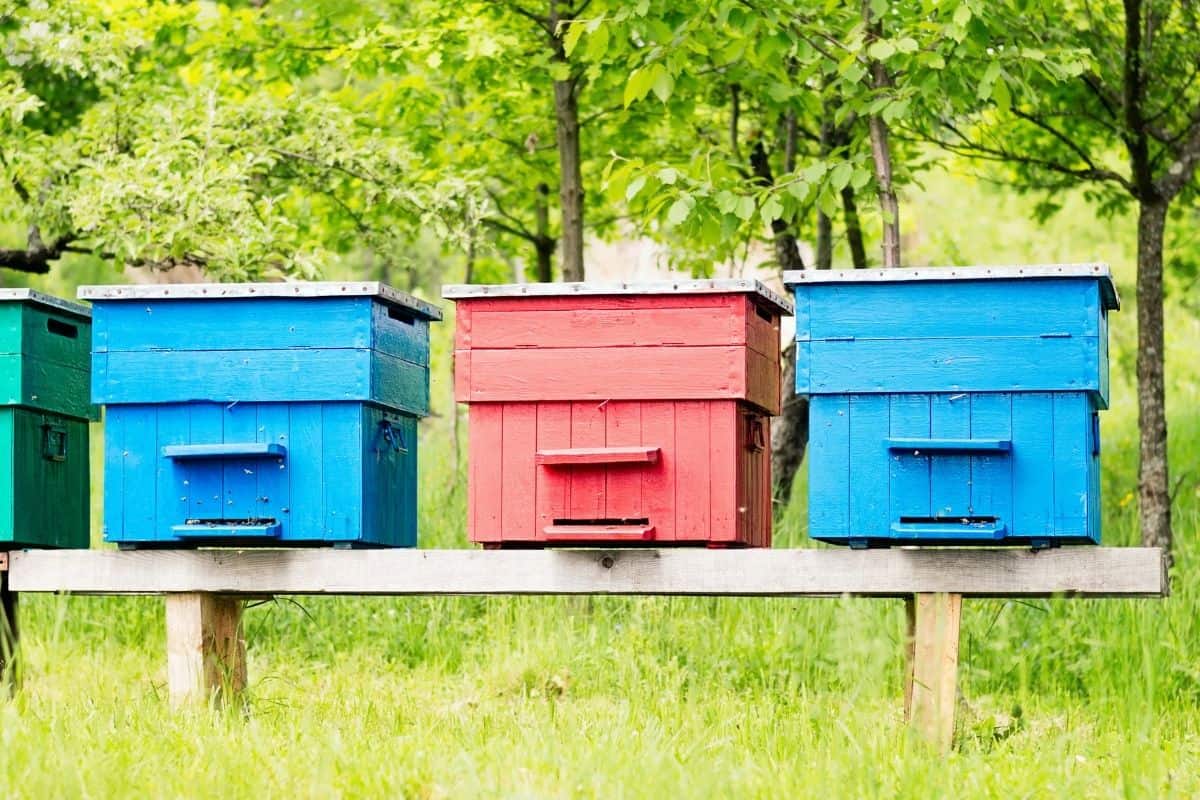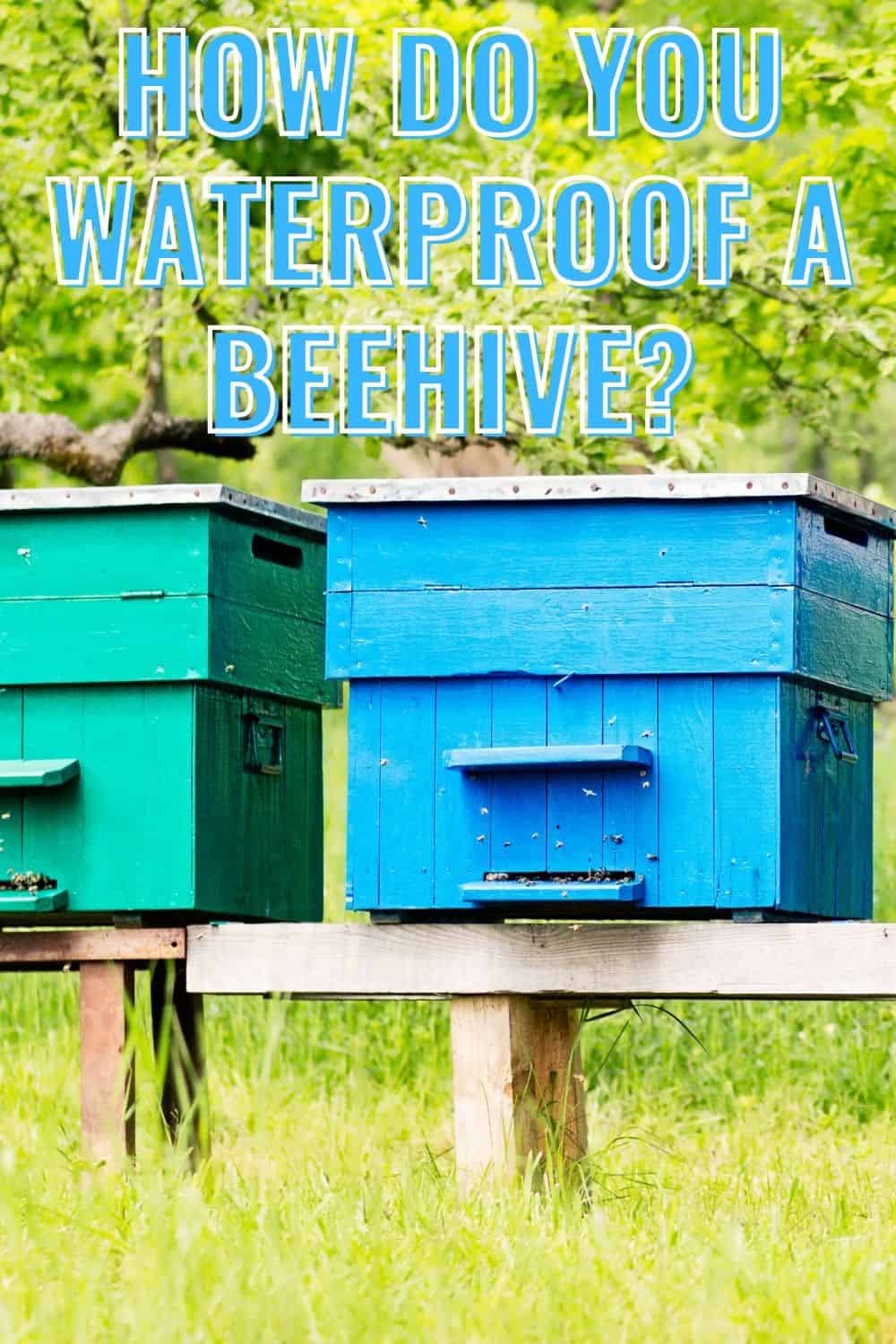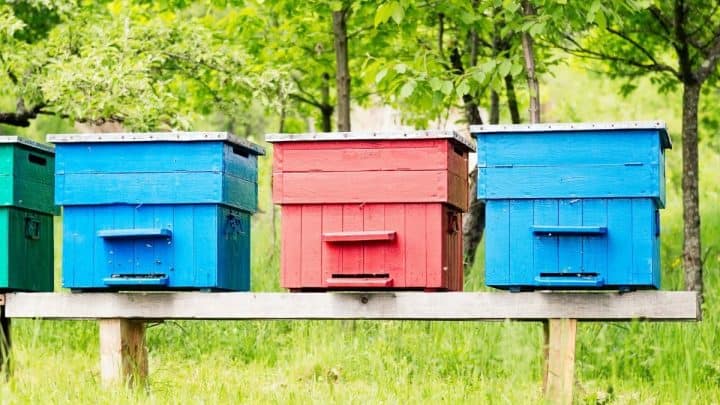As a beekeeper, you’ll want to preserve your beehives for as long as possible. Not only to protect your bees but to avoid the expense and hassle of replacing rain-damaged hives. By waterproofing your beehive, you’ll also be protecting the wood from other weather elements like the sun and snow. But how do you waterproof a beehive?
The best way to waterproof a beehive is to seal the wood with a product that protects the wood from rain damage and rot. The hive can be waterproofed with paint, clear varnish, wax dip, or exterior stains. Pay special attention to tightly sealing all joints for maximum waterproofing and longevity.

There are so many methods to waterproof a hive! They will depend on your hive material, the weather conditions in your area, and how long you hope your hive to last.
While some methods may be more expensive or require more time than others, you will still have to maintain your hives to keep them waterproof. I’ll detail what happens if you decide not to waterproof your hive and the different sealing methods available. Each method will have pros and cons, and the best one will be the one that suits your time, budget, and expectations.
What Happens if A Beehive Gets Wet?
While you don’t want to spend your time replacing beehives that have become warped by wind and rain, there’s another downside to not waterproofing your hive. If moisture can penetrate your hive, it creates a breeding ground for all kinds of dangerous organisms. A wet hive will allow fungi to grow, molds to spread, and diseases to thrive.
Allowing rain to get into your beehive can spell a slow death for your colony. Just as we don’t like it when our homes are cold and wet, neither do bees.
The best beehive will be suited to the yearly climate. For example, a beehive that regularly endures long cold winters should be built with thicker lumber than one in a dry, warm country. Even if you get only a little rain, it is still best practice to waterproof your beehive for additional protection from the elements.
Are you a new beekeeper? Check out this beekeeping starter kit.
How To Seal A Bee Hive
You can seal a beehive with several products, all with varying degrees of time, cost, and longevity. While all the sealants will need to be regularly maintained to prevent moisture from penetrating and rotting the beehive wood, some products will last longer than others.
The cheapest and easiest method to waterproof a beehive is to paint it with latex or oil-based paint. Painting your hive is one of the most common methods and allows you to use different colors.
Other methods include using a clear polyurethane varnish, outdoor wood stain, marine varnish, or water-dispelling oil such as tung or linseed.
Wax sealing your wood is another option, and a combination of beeswax and linseed oil will form a good protective barrier that still allows the natural wood grain to show.
Beehives are exposed to the elements, and they are regularly opened and closed as honey is harvested or hive bodies moved. This use means you will want to choose a seal that you can easily touch up and withstand cracking from the movement.
Bee Hive Paint, Stain, Or Varnish
Since beehives have to be kept outdoors, the wood will need additional protection if you hope to have your hives last for more than 5 or 6 years. Of course, more expensive, harder woods will last longer, but even a soft wood like pine can be treated to make it waterproof and save you running costs and the extra work of preparing new modular Langstroth hives and transferring your colonies.
Paint
It’s very simple to waterproof your hive by using high-quality semi-gloss exterior paint. You can use oil-based paints or latex, though latex is cheapest and easy to clean up, with a shorter drying time.
Beekeepers generally prefer to use semi-gloss over matte because the gloss makes it easier to wipe down the hives to keep them clean.
A painted beehive will need to be repainted every few years to keep the seal strong and the paint looking fresh. If you choose to paint the inside of the hive for extra protection, only use latex paint to do so.
Wood stain
What if you prefer a more natural look to paint? Consider using a non-toxic wood stain designed for exterior use. A stain will darken the wood and make it look naturally aged while still protecting it from the elements. The stain bonds with the wood to help create a waterproof surface.
If you choose to use wood preservatives, make certain they contain no pesticide and will not harm your bees.
One alternative to traditional wood stains and sealers is Eco Wood Treatment, an outdoor wood stain known for its low maintenance and longevity. It is used by Nova Scotia Natural Resources to protect their picnic tables.
Clear varnish for beehive
Most stains may need an extra coat of clear sealant to help protect the wood. When choosing a clear sealant, consider using yacht varnish – although the drying time is longer, the seal is more flexible, which helps the waterproofing withstand the handling a hive will go through.
Sealants can be painted or sponged on over your stain. Work in thin layers for best results. Allow drying time before applying subsequent layers, and make sure all the joints are thoroughly sealed.
Painting Bee Hives With Linseed Oil And Beeswax
Melting beeswax and linseed oil together will give you a good, deep-penetrating protective and non-toxic seal that can be painted onto your hive.
- The wax and oil can be easily melted together over a pot of boiling water – the same way you would melt chocolate.
- When the mixture has cooled a little, you can sponge or paint it generously onto the wood. The wood will soak up the oil mixture and create a deep seal.
- Pay attention to sealing all the joints and end wood to ensure these weaker areas are properly sealed.
- Allow the initial coat of sealer to dry completely, and apply as many layers as necessary. While the wood will darken with the seal, you will still be able to see the natural wood grain.
- Some beekeepers also prefer to seal the interior of the hive as well as the exterior.
- Use a roll of aluminum sheeting to cover any exposed joints that require extra protection, such as the roof joint.
Wax Dip For Bee Hives
One of the best methods for sealing and waterproofing a beehive is to treat all the wood with a wax dip. However, while many beekeepers love it, this treatment can be extremely expensive and labor-intensive, which makes it more practical for beekeepers with many hives to dip.
Wax dipping will penetrate every part of the hive and replace any moisture in the wood with wax, making this an extremely durable form of waterproofing.
Hudson Valley Bee Supply has an informative video detailing how they wax-dip their beehive boxes.
You can also buy hives that have already been wax dipped, which might be the best choice if you want wax-dipped hives and do not feel like DIYing your hives from scratch.
Conclusion
It is best to seal your beehives to provide them with waterproof protection. Waterproofing your hive keeps the wood from warping and rotting and keeps your colony healthy. The cheapest and easiest option for most backyard beekeepers is to use latex paint to seal your hives. Other options can be to stain and varnish your hives, or, for an extremely durable and non-toxic seal that leaves the natural wood grain showing, you can wax-dip your hives.




Quick Introduction To Beekeeping
Wednesday 3rd of August 2022
[…] How Do You Waterproof a Beehive? A Quick Guide to Extending Your Hives’ Life […]
Reliable Dadant Beekeeping Supplies For Beginner Beekeepers
Thursday 11th of November 2021
[…] Related: How to waterproof a beehive. […]